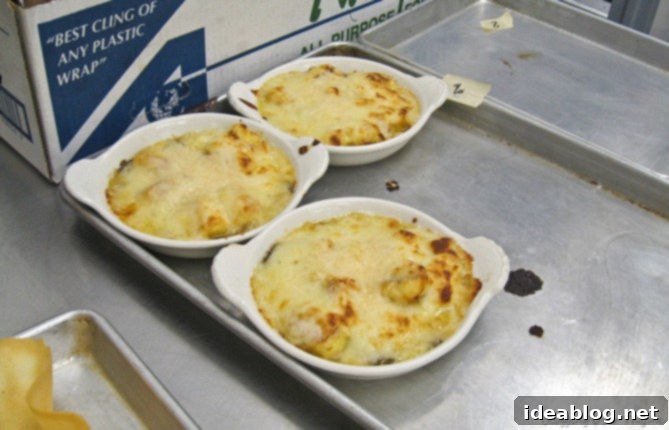A Culinary Marathon: Mastering French Classics from Mousse to Braised Lamb in a Jam-Packed Day
The countdown to Phase II of my culinary program has officially begun, and with just three weeks remaining, the excitement – and a hint of trepidation – is palpable. Time in the kitchen seems to fly by, and I have no doubt that the next phase will be here before we know it. But for now, let’s dive into the incredible culinary journey that unfolded today.
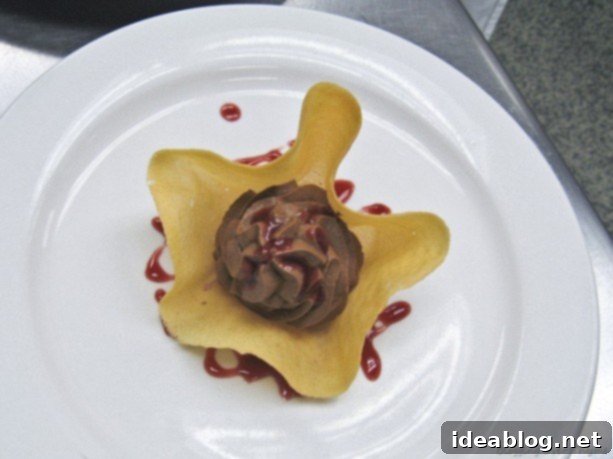
An Action-Packed Menu: From Delicate Desserts to Savory Staples
Today’s whiteboard revealed a formidable lineup of four distinct dishes, each promising a multitude of steps and requiring meticulous attention to detail. It was truly a jam-packed day, pushing our skills and our time management to their limits. Our first task upon entering the bustling kitchen this morning was the creation of a classic French delight: chocolate mousse.
Crafting Silky Chocolate Mousse
This particular variation of chocolate mousse proved remarkably straightforward to assemble, relying on fundamental pastry techniques. We began by whipping egg yolks, whole eggs, and sugar together until they reached a crucial stage known as “ribboning.” This means the mixture becomes significantly thick, turns a very pale yellow, and when lifted with a whisk, it drizzles back into the bowl in a distinct, ribbon-like pattern that holds its shape for a moment before dissolving. This airy, stable base was then carefully folded into rich, melted semisweet chocolate, creating a luscious foundation. The final touch was the incorporation of freshly whipped cream, which lent the mousse its characteristic light and airy texture.
While an ideal chocolate mousse truly benefits from several hours, or even an overnight stay, in the refrigerator to properly set and develop its full flavor, our culinary program often requires us to accelerate processes. Today, we employed an ice bath to rapidly chill and set the mousse, allowing us the satisfaction of serving this decadent dessert at lunch – a testament to efficient kitchen techniques.
The Art of Tulip Cookies: Edible Elegance
To serve our elegant chocolate mousse, we opted for a sophisticated presentation: piping the mousse into delicate tulip cookies. These beautiful, edible cups are renowned for being notoriously tricky to master, demanding speed and precision immediately after baking. The process is quite similar to making the cigarette cookies we tackled a few weeks prior.
The batter, a thin, spreadable consistency, is applied incredibly thinly onto a baking sheet, often using a stencil to ensure uniform size and shape. An offset spatula helps achieve the perfect, even layer. These delicate wafers bake for an astonishingly short period – barely 4-5 minutes – after which they must be swiftly picked up and molded into their distinctive tulip cup shape. This rapid manipulation before they cool and harden is where the challenge lies, making patience and quick hands essential virtues in their creation.
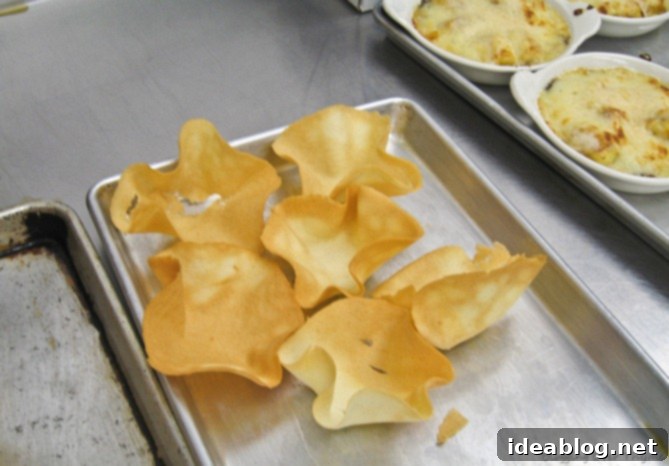
As is often the case with such intricate pastry work, some of our tulip cookies didn’t emerge from the molds in perfect form. Achieving consistent results truly requires extensive practice and a keen eye. While my table partner, Blanca, adeptly managed the creation of these challenging cookies, I shifted my focus to the other savory components of our ambitious menu.
Beyond the Sweet: Savory French Delicacies
Unconventional Parisian Gnocchi with Duxelles and Mornay Sauce
Our appetizer for the day was a dish that immediately sparked curiosity: Parisian gnocchi served with a rich duxelles. For those unfamiliar, duxelles is a finely minced mixture of sautéed shallots and mushrooms, typically used as a flavorful base or component in various French dishes, imparting an earthy, umami depth.
However, as I’ve noted before, this was decidedly *not* the traditional potato or ricotta gnocchi that might come to mind. In fact, until today, I had never even encountered this unique variation! It certainly sounds unconventional to describe, but its execution is fascinating. Parisian gnocchi is crafted from pate a choux dough – yes, the very same versatile dough used to create beloved pastries like eclairs and profiteroles. This unexpected base gives the gnocchi a light, airy, yet resilient texture that sets it apart.
To prepare these intriguing gnocchi, we piped the pate a choux in long, continuous strips onto a lightly floured baking sheet. These strips were then chilled in the freezer, allowing them to firm up slightly for easier handling. Once set, we cut them into uniform one-inch pieces. Much like their potato-based counterparts, these segments were then cooked in boiling water until they became wonderfully pillow-y soft, signaling their readiness.
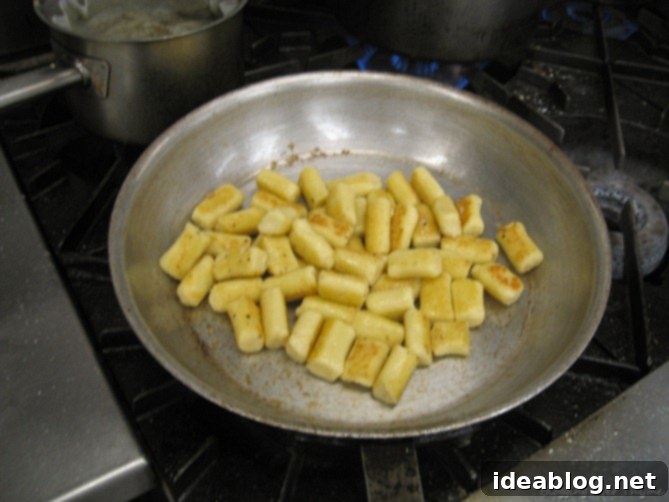
Immediately after cooking, the gnocchi were transferred to an ice bath, a crucial step to halt the cooking process and preserve their delicate texture. After a quick drying, they were finally sautéed in clarified butter until beautifully golden brown, adding a crisp exterior to their tender interior.
But the preparation didn’t end there! Once our gnocchi were perfectly sautéed and ready, we generously greased gratin dishes. A spoonful of the aromatic duxelles mixture was added to each dish, followed by a generous portion of the cooked gnocchi. The pièce de résistance was then ladled over everything: a rich, velvety mornay sauce. Mornay sauce is essentially a classic béchamel sauce elevated with the addition of Gruyère or Parmesan cheese, lending a creamy, savory, and undeniably comforting quality to the dish.
A final sprinkle of cheese adorned the top of each gratin, and they were then transferred to the oven to “gratinee,” a French culinary term meaning to brown or crisp the surface under intense heat. The result was a seriously rich, indulgent dish. Despite its decadence, I thoroughly enjoyed the unique texture and flavor of the gnocchi itself. It’s a dish I’d love to recreate at home someday, perhaps experimenting with a vibrant pesto or a simple, fresh tomato sauce to complement its richness.
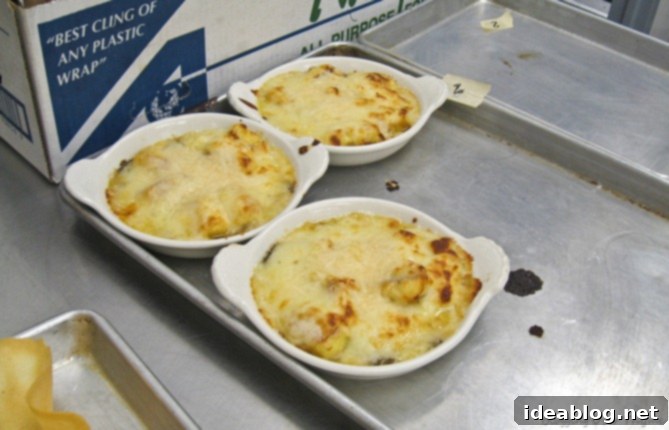
Hearty Braised Lamb Shanks with French Green Lentils
Moving on to another substantial dish from our packed schedule, we also prepared magnificent braised lamb shanks with lentils. The process began by searing the lamb shanks to achieve a beautiful crust and lock in their juices. Following this, they were braised in a flavorful liquid, a technique similar to our other stew preparations, involving a classic mirepoix (diced carrots, celery, and onions), a splash of wine, rich veal stock, and an array of aromatic herbs and spices. This slow, moist cooking method in the oven ensured the lamb became incredibly tender, almost falling off the bone, until it was ready for service.
While I’m not typically a fervent lamb enthusiast, sometimes finding its flavor a bit too gamey for my palate, lamb shanks prepared through braising are undoubtedly my favorite. The prolonged cooking breaks down the connective tissues, resulting in succulent, melt-in-your-mouth meat with a deeply developed flavor. Serving these tender shanks on a bed of earthy French green lentils proved to be an excellent pairing, balancing the richness of the lamb with the lentils’ wholesome texture and subtle peppery notes.
The French green lentils themselves were cooked to tender perfection with additional aromatics, including onion, celery, and carrot, adding another layer of flavor and texture to the dish. Interestingly, today marked our very first time cooking with dried beans in the program, a foundational skill that opens up a world of culinary possibilities.
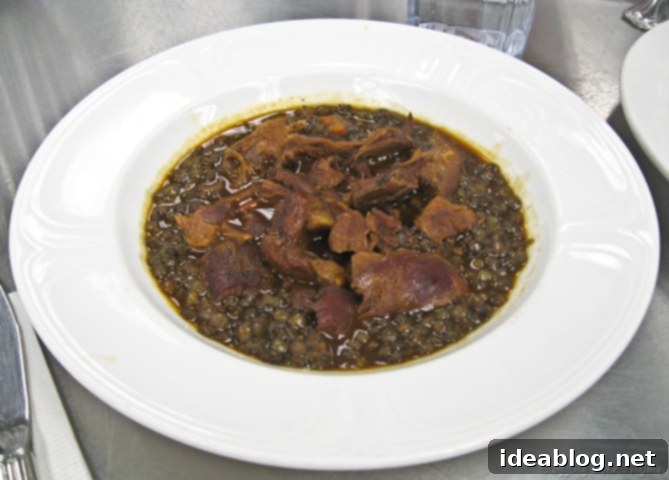
Preparing for Tomorrow: Ladyfingers and Essential Lessons
The Delicate Task of Ladyfingers
As if the array of dishes we had already tackled wasn’t enough to accomplish in a mere two hours (the sarcasm here is intentional, given the sheer volume of work!), we were also tasked with making delicate ladyfingers. These classic sponge cake biscuits are a crucial component for tomorrow’s class, where they will form the base of a luxurious tiramisu.
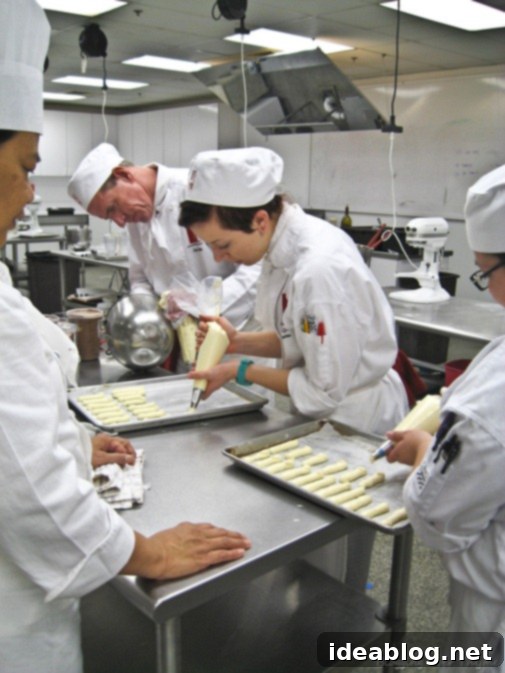
Predictably, the ambitious timeline meant that none of us managed to complete these intricate biscuits before lunchtime. So, after a brief respite, we regrouped and dedicated ourselves to swiftly producing a batch of ladyfingers. The goal is to achieve an exceptionally crispy and dry texture, which is paramount for their role in absorbing the coffee and liqueur in tiramisu without becoming soggy.
Here are my freshly baked ladyfingers, patiently drying on the rack, awaiting their destiny in tomorrow’s tiramisu creation. Their crispness will be key to the structural integrity and textural contrast of the final dessert.
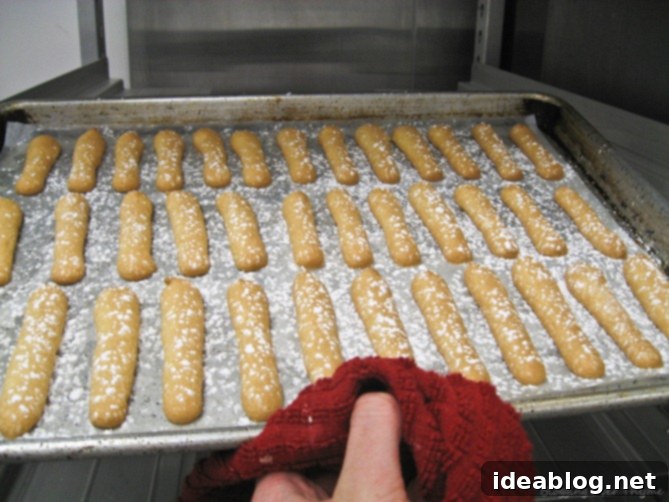
Beyond the Kitchen: Chef Francois’s Meat Lecture
By the time we had served lunch, completed our ladyfingers, diligently trimmed chicken bones for future stock, and initiated the extensive cleaning process, we found ourselves scrambling against the clock. We had to make a swift transition from the bustling kitchen to the classroom for Chef Francois’s much-anticipated weekly meat lecture.
This week’s agenda, quite fittingly given our braised lamb shanks, focused entirely on lamb. During the lecture, Chef Francois masterfully broke down an entire lamb carcass. He meticulously pointed out all the primal cuts, demonstrating how a whole animal is portioned for culinary use. He also skillfully assembled a beautiful rack of lamb and prepared a roast using the tenderloin, showcasing the versatility and value of each part. This single photo I managed to capture only offers a glimpse into the intensity and detailed nature of the demonstration.
Witnessing the butchering of an entire animal was an incredibly insightful and intense experience. Having never seen such a process up close before, it provided a profound understanding of where our ingredients come from and the craftsmanship involved in preparing them for the kitchen. It’s a vital lesson in respecting the animal and maximizing its potential in cooking.
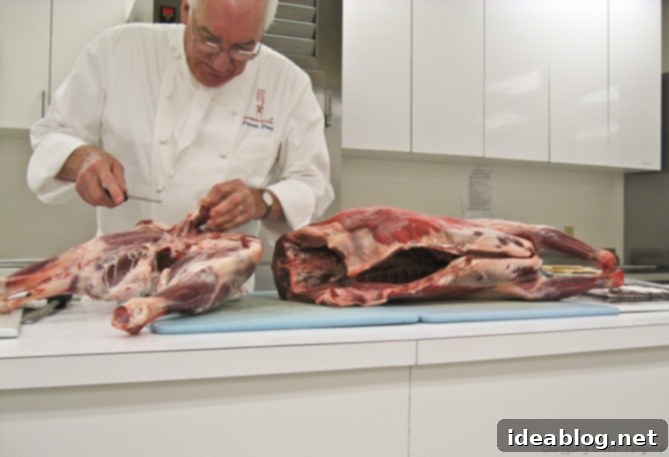
I apologize if this image is a bit too graphic for some readers. If it is, please feel free to scroll down and explore my latest post featuring delightful Meyer lemon tarts – a far more photogenic and less intense culinary subject, if I do say so myself!
